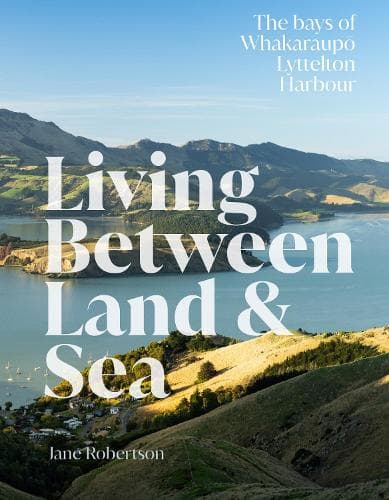Review — Living Between Land and Sea
Reviewed by Bob Frame
This sumptuous social and environmental history of Whakaraupō Lyttelton Harbour takes the reader around the harbour that separates Ōtautahi Christchurch from Te Pātaka o Rākaihautū Banks Peninsula.
Local historian and educator Jane Robertson was intrigued by the numerous jetties around the harbour. They are in the tidal zone, the takutai moana, that is both land and sea, and this is where her interest lies, “particularly those [jetties] in varying states of decay… both beautiful and poignant.”
The book’s clockwise journey around the harbour starts at the signal station at Te Piaka Adderley Head and ends at the lighthouse at Awaroa Godley Head, stopping at 17 bays and islands along the way. At each, jetties were essential to the harbour’s Māori communities and early European settlers. Social histories covered in the book include stories from Te Hapū o Ngāti Wheke as well as other tales of dramatic rescues, farming and trade history, wartime experiences, life in quarantine stations, plus tourism and recreational use of Whakaraupō Lyttelton Harbour. Today, the jetties are part of the harbour’s built heritage, with many still serviced by ferries, launches and other maritime craft, and a very active sailing community – not least the SailGP regattas, which introduce the harbour to a global television and online audience of more than 100 million.
Robertson’s lavishly illustrated history — there are more than 150 contemporary and historical photos — is full of keenly observed insights into the challenges of living in small, relatively remote communities. This is supported by extensive notes, a rich bibliography and a glossary of te reo Māori and place names.
The stories are about much more than the jetties. Robertson weaves details about the importance of conservation and ecological restoration throughout, and there is much more that could be added. Initiatives are gradually advancing the Whaka-Ora Healthy Harbour vision of restoring the environmental and cultural health of the harbour. The public conservation park, Te Ahu Pātiki, is another recent development in the harbour. It includes the two highest peaks on Te Pātaka o Rākaihautū Banks Peninsula and is part of the Te Ara Pātaka track network. The book also mentions the aspirational Head to Head walkway project that seeks to create a continuous walkway around the coastline from Awaroa Godley Head to Te Piaka Adderley Head.
Support for the book came from several local institutions and charities. All of these are indicators of the importance of this book, its integration with the local community, and the importance of that place between the land and the sea.
Massey University Press have, as with other recent titles, produced a beautiful ‘more-than-just-a-coffee-table-book’, hopefully carving a path for other social and environmental histories of significant places around the coast of Aotearoa New Zealand.
Reviewed by Bob Frame
Bob Frame is currently an Adjunct Professor in the School of Earth and Environment at the University of Canterbury. He has worked in several countries and published in a wide range of disciplines. He now lives very happily in Whakaraupō Lyttelton Harbour from where he engages in various outdoor pursuits.
